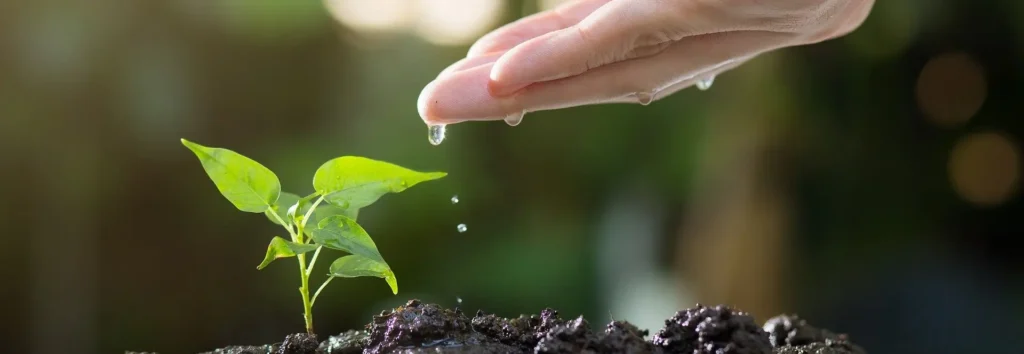A slow lifestyleis a simple approach to living. It emphasizes mindfulness, and encourages individuals to slow down the pace of their lives. It intentionally focuses on what truly matters, and prioritizes quality over quantity in various aspects of life. The concept is rooted in the broader “slow movement,” which began with the slow food movementin the 1980s as a reaction against fast food and the fast-paced, consumer-driven culture. Here are some key aspects of a slow lifestyle:
A Slow Lifestyle Keeps You in the Present
A slow lifestyle places a strong emphasis on mindfulness. Mindfulness is a practice of being fully present in the moment without judgment. It encourages you engaging with your surroundings, thoughts, and emotions in a conscious and deliberate way. Instead of rushing through tasks or letting your mind wander to past regrets or future worries, mindfulness encourages you to focus on what’s happening right now.
You can practice eating mindfully to embrace a slow lifestyle. Avoid eating meals on the go. A slow lifestyle encourages you to savor each bite, paying attention to the flavors, textures, and aromas of your food. This not only enhances the dining experience but also aids digestion and helps prevent overeating and obesity. Mindful eating enhances the enjoyment of meals, helps regulate portion sizes, improves digestion, and prevents overeating. It encourages you to listen to your body’s hunger and fullness cues, and builds a healthier relationship with food.
Avoid multitask or rush through workdays. This leads to burnout and mistakes. A slow approach to work involves focusing on one task at a time, giving it your full attention, and taking breaks when needed. This leads to higher quality work and greater satisfaction.
In a world filled with distractions, it’s easy to be physically present but mentally absent when spending time with family or friends. A slow lifestyle encourages you to put away your phone, listen actively, and engage fully in conversations. This deepens relationships and fosters stronger emotional connections.
Mindfulness is not just about external actions but also about tuning into your internal state. It involves observing your thoughts and feelings without judgment. This helps reduce stress and improve mental clarity. Practices like meditation, deep breathing, even simply pausing to notice your surroundings help cultivate this awareness.
Mindfulness allows you to slow down the mental chatter and let you experience life as it unfolds.
Slow Lifestyle Balances Life with Work
A slow lifestyle challenges the modern world concept of busyness and productivity. It advocates for a healthier work-life balance. The idea is that life is not just about achieving professional success; it’s also about nurturing personal well-being, relationships, and passions.
One of the key aspects of achieving work-life balance is setting clear boundaries between work and personal life. Designate days for work, and another day for rest. Don’t check emails frequently on holidays. If you work remotely, create a dedicated workspace at home. By doing so, you create a mental separation that allows you to fully disconnect from work and recharge.
A slow lifestyle encourages you to evaluate your commitments and say “no” to activities that don’t align with your values. This frees up time for more meaningful pursuits. You can spend more time with loved ones, and pursue hobbies.
Rest is not laziness. It’s an essential for maintaining physical and mental health. A slow lifestyle emphasizes the importance of downtime. Spend your time through regular vacations, and weekend getaways. Rest allows you to recharge, boosts creativity, prevents burnout, and increase productivity.
A slow lifestyle may involve seeking out flexible work arrangements. You can choose working remotely, a part-time schedule, or freelance opportunities. These options allow individuals to better manage their time and prioritize personal well-being alongside professional responsibilities.
In terms of work, a slow lifestyle encourages focusing on the quality of your output rather than the quantity of tasks completed. This means taking the time to do things right, rather than rushing through them just to check them off a list. It also means valuing depth over breadth in your professional and personal endeavors.
Slow Lifestyle Supports Sustainable Living

Slow lifestyle goes hand-in-hand with sustainable living. Their aims are same -reducing waste, consuming thoughtfully, and considering the long-term impact of our choices on the environment and society. Sustainability is not just about environmental concerns; it’s also about creating a lifestyle that is resilient, ethical, and mindful of future generations.
A slow lifestyle encourages people to buy less. Resist the urge to constantly purchase new items. Instead, focus on what you truly need. You are saving money by buying less. By reducing consumption, you are reducing the demand for resource-intensive production processes.
Supporting local farmers, artisans, and businesses is a key aspect of sustainable living. When you buy locally, you reduce the carbon footprint associated with transporting goods over long distances. Additionally, locally sourced products are fresher and of higher quality. For example, buying seasonal produce from a nearby farmer’s market supports the local economy and reduces environmental harm.
A slow lifestyle promotes practices that minimize waste. It also encourages repairing broken items instead of immediately replacing them. The concept of “zero waste” has gained popularity, where individuals aim to send as little as possible to landfills by adopting reusable alternatives.
Slow living encourages people to think critically about the products they buy and the companies they support. This involves choosing fair-trade goods, avoiding products made with exploitative labor practices, and opting for brands that prioritize sustainability and ethical sourcing. By making informed choices, you can contribute to a more equitable and environmentally friendly world.
Sustainable living is about considering the long-term consequences of your actions. This encourages you to invest in durable, high-quality items that last longer, even if they cost more upfront. It also involves thinking about how your daily habits—such as energy use, transportation choices, and food consumption—affect the planet and future generations.
Slow Lifestyle Prioritizes Quality Over Quantity
A slow lifestyle places a strong emphasis on the principle of quality over quantity. This philosophy applies to nearly every aspect of life. It’s better to have fewer, high-quality things or deeper, meaningful connections than to accumulate a large number of disposable items.
Manufacturers are constantly putting presser on your mind to buy new things. They are convincing you of buying the latest clothes, gadgets, and home decor. However, a slow lifestyle encourages people to invest in well-made, durable items. These items last longer and provide greater value over time. For example, choose to purchase a few high-quality pieces instead of buying cheap trendy clothing. High quality clothing is timeless and built to last.
A slow lifestyle values nutrient-dense foodsover processed foods. By focusing on this principle, you are enjoying better taste and supporting your health.
A slow lifestyle also encourages you to seek out meaningful experiencesrather than simply accumulating a large number of activities or vacations. Instead of rushing through a packed itinerary, spend a weekend hiking in nature, immerse yourself in the beauty of the outdoors, and take a cooking class to learn a new skill. These experiences leave a lasting impression and contribute to personal growth.
In terms of human connections, a slow lifestyle prioritizes depth over breadth. Rather than trying to maintain a large network of acquaintances, focus on nurturing a smaller circle of meaningful relationships. This involves spending quality time with loved ones, listening deeply, and being present in your interactions. These deeper connections foster trust, empathy, and emotional support, which are essential for long-term happiness and well-being.
Health Benefits of a Slow Life

A slow lifestyle practices that promote balance, mindfulness, and self-care. So, it inherently supports physical and mental health.The fast pace of modern life often leads to stress, and burnout, but a slower approach allows you to tune into your body and mind.
Slow lifestyle emphasizes movement that feels goodrather than pushing yourself to exhaustion. Engage yourself in activities like yoga, walking in nature, swimming, and dancing. You can do anything that brings you joy and helps you stay active without the pressure of intense workouts. The key is finding forms of exercise that you genuinely enjoy.
Sleep is often sacrificed due to work-pressure in a fast-paced world. Slow lifestyle recognizes the importance of restorative sleepfor both physical and mental health. Prioritizing a consistent sleep schedule, creating a relaxing bedtime routine, and ensuring a comfortable sleep environment are all ways to improve the quality of your rest. Adequate sleep boosts immune function, enhances mood, and improves cognitive performance, making it a cornerstone of a healthy lifestyle.
Listen to your body’s signalsand respect its limits. Give yourself permission to rest when you’re tired. Practice self-awareness and self-compassion. They prevent burnout and maintain a sense of balance in your life.
Your physical, mental, and emotional well-being are interconnected. A slow lifestyle takes a holistic approachto recognize this. This incorporates journaling, therapy, and creative expression into your routine to support emotional health.
Slow Life Connects You with Nature
A deep connection to nature has profound benefits for both mental and physical health. Reconnecting with nature is a way to slow down, find peace, and gain perspective on life.
One of the simplest ways to embrace a slow lifestyle is by spending more time outside. Go for a walk in the park, hike in the mountains, or just sit by a lake. Being in nature has a calming effect on the mind and body. Studies have shown that spending time in green spaces reduces stress, lowers blood pressure, and improves mood. Nature provides a sense of tranquility that is lacking in urban environments.
Gardeningaligns perfectly with a slow lifestyle. Tending to plants allows you to connect with the rhythms of nature. Gardening also encourages patience. You keep patience as plants require time and care to flourish. Growing your own fruits, vegetables, and herbs is a fulfilling way to nourish yourself.
Nature serves as a source of creativity and inspiration. It is a creative space for writers, artists, and thinkers. Nature provides them ideas and insights. Spending time in nature spark creativity, encourage reflection, and provide a sense of clarity that is difficult to achieve in the hustle and bustle of daily life.
Slow Lifestyle Makes Technology Your Friend
Technology plays a central role in nearly every aspect of our daily life. While it offers many conveniences and opportunities, excessive reliance on technology leads to stress, distraction, and a sense of disconnection from the real world. A slow lifestyleencourages individuals to use technology in a meaningful way and to step back from constant connectivity.
Limit screen time. This doesn’t mean completely cutting off technology. Divide your time for spending on smartphones, tablets, and computers. Setting boundaries helps you reclaim time for meaningful activities. Avoid screens during meals, in the morning, or an hour before bed to promote better sleep.
Social media platforms are designed to keep users engaged for as long as possible. A slow lifestyle encourages people to be intentional about their social media use. Don’t avoid social media for the rest of your life. Rather set time limits for social media app. Unfollow accounts that don’t bring value. Take regular breaks from these platforms altogether. Instead of passively consuming content, read meaningful and helpful articles to bring value to your life.
A slow lifestyle prioritizes real-world interactionsover virtual ones. Spending quality time with family, friends, and community members fosters deeper relationships and a greater sense of belonging. Make a conversation without distractions, play board games, and engage in shared activities with family and friends. These moments create lasting memories and strengthen bonds. By reducing screen time, you are freeing up space for these enriching experiences.
Periodically disconnect yourself from technology entirely. This is known as a digital detox. This can be a powerful way to reset your relationship with devices. Take a weekend away from screens, go on a tech-free vacation, or simply spend a day outdoors without your phone. During these detoxes, you can reconnect with yourself, nature, and the people around you.
A slow lifestyle doesn’t necessarily mean rejecting technology altogether. Rather it encourages mindful use. Use technology intentionally and purposefully. Control the devices rather than letting it control your attention. Use apps that help you track your screen time, set reminders to take breaks, and schedule specific times for checking emails and messages. Be deliberate about when and how you use technology. The technology is your friend, but overuse make it a source of stress and distraction.
Slow Lifestyle Let You Enjoy Workspace and Creativity
You can spend adequate time with your creativity and hobbiesin a slow life.
Creativity comes in many forms. Slow lifestyle encourages you to explore different outlets of creativity. Painting, drawing, writing, photography, and craftingallow you to express yourself and tap into your inner world. Engaging in creative pursuits can be both relaxing and energizing. They provide a sense of flow and immersion that helps you forget about daily stresses.
Cooking and bakingare creative endeavors. Preparing meals from scratch, experimenting with new recipes, and growing your own ingredients can be a deeply satisfying way to connect with food and culture. Cooking mindfully can turn meal preparation into a meditative experience.
Make a time to learn to play an instrument or engage yourself in musical activities. This can be a powerful form of self-expression. Music has the ability to evoke emotions.
Writing is another powerful way to explore self-reflection. Keep a journal, process your thoughts, document your experiences, and set intentions for the future. Creative writing—whether it’s poetry, short stories, or essays—can be a way to express your imagination and share your perspective with others.
A key aspect of creativity in a slow lifestyle is the idea of slowing down to create. Rather than rushing to finish a project, take your time to enjoy the process. This approach allows you to experiment, make mistakes, and learn along the way. It’s about valuing the journey as much as the destination. This helps you to enjoy your work and leads to a deeper sense of satisfaction.
Join a local art class, book club, or music group. Connect with like-minded individuals who share your interests. These social connections enhance your creative journey and provide support and inspiration.
A slow lifestyle is not about doing everything slowly or being unproductive. It’s about being intentional with your time and energy. It focuses on what brings meaning and joy to your life, and rejects the pressures of a fast-paced, consumer-driven society. It’s about finding a rhythm that works for you, and allows you to live fully and authentically.




